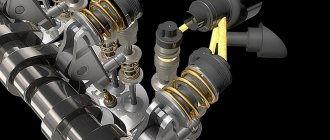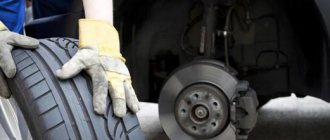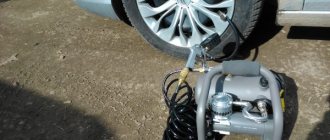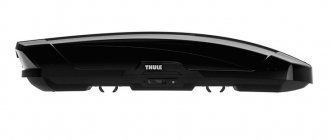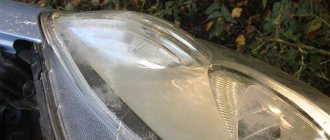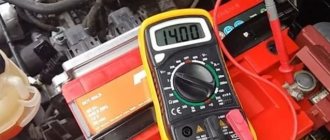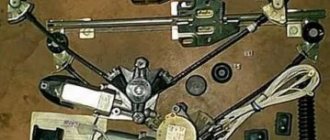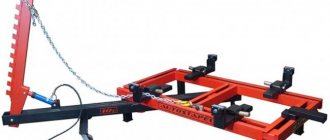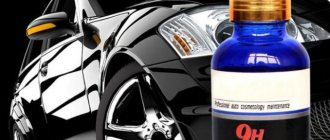With the arrival of spring and the need to replace studded tires, all car enthusiasts are faced with the problem of choosing the right tires with a regular tread: which ones will provide the best grip, what pitfalls there are when choosing, which manufacturer is better. Contacting tire shops does not always help: some of them are not competent enough, others offer the most expensive tires from a certain manufacturer that they have due to the concluded contract. In this article we will tell you how to choose the right summer tires for your car, what types of tires and treads exist, and what to look for when purchasing.
Standard size
When choosing tires yourself, first of all, look at the standard size. You can see it on the sidewall of the tire. For example, let's take a 185/55 R16 tire. Let's look at what this means element by element.
- 185 – profile width in mm. In this case 185 mm.
- 55 – ratio of profile height and width. Indicated as a percentage. In this case, the height is 55% of the width.
- R – tire design. This letter denotes radial tires.
- 16 – internal (landing) diameter. Indicated in inches.
But these are not all the parameters that can be seen on the sidewall. The Latin letter “C” is also sometimes placed there. This is how tires are designated for use on commercial vehicles, these can be light trucks or small buses. Rubber for them is selected to be more resistant to loads and also resistant to wear.
When deciding which tires to choose, you should take into account the operating characteristics and driving style. This is especially true for profile height. The smaller this parameter, the higher the controllability. Accordingly, if you only drive on asphalt and country roads, it is better to select tires with a 45-55 profile. But here you need to remember that such tires absorb impacts worse when hitting obstacles.
For a quiet ride, without speeding. It is optimal to choose tires with a profile height of 60-70%; they will provide an excellent combination of handling and comfort.
For lovers of outdoor and off-road trips, high-profile tires will be the best solution. They will provide optimal cross-country ability. For the most difficult cases, you can purchase full-profile tires that have a height of 80% or more; you can distinguish them by the absence of this parameter on the sidewall. But it is worth remembering that high-profile tires have poor stability at speed.
It is better to purchase summer tires wider than winter tires.
Load capacity matters too
There are more markings on a tire than on any other part. In addition to the name and size, a lot of other things are encrypted in them: the date of manufacture of the tire, the country of manufacture, permissible speeds and loads, as well as the type of surface on which it can be driven.
But in order to choose the right summer tires for a car (and winter ones too), you also need to take into account the category of vehicles for which they are intended.
There are only three categories, and in order to correctly choose the best summer tires for your favorite iron horse, you need to know about them:
Passenger transport
P – passenger. Passenger (passenger) vehicles include small-sized vehicles carrying passengers of up to 8 people and light cargo. Typically, such a tire is not additionally marked.
Light truck
LT – light truck. Light trucks include minivans and SUVs, pickups and vans with a capacity of up to 1 ton. The tire intended for them has a large number of layers and is marked with the prefix LT.
It has a reinforced cord and thickened sidewalls, resulting in increased strength. The speed index of this tire is much lower than that of passenger tires.
LT category tire
Commercial
C – cargo. This category of tires is designed for commercial vehicles in the form of small trucks, buses and pickups (essentially the same thing). The manufacturer often adds the word “cargo” to the name of the tires, and also attaches the letter “C” to the load capacity index or radius.
Commercial vehicle tire designation
In principle, LT tires are not too different from C tires, since both are reinforced. Much still depends on the country of origin. In Europe (and in Russia too) the designation C is mainly used, in Asia and America - LT.
As for the parameters, tires with both designations are suitable for small trucks - the main thing is not to choose a tire without reinforcement at all. And by the way, truck tires most often have an A/T type tread.
Types of summer tire tread
It is also important to choose the right tread. Traffic safety largely depends on it. It is necessary to take into account the peculiarities of operation, as well as weather conditions during the summer season. There are four types of protectors.
- Symmetrical non-directional. Both halves of the profile are mirrored. But there is no clear direction of movement. The tread provides effective traction regardless of the direction of rotation. Considered a budget option. Not very good at high speeds. They also do not remove water from the contact patch very reliably.
- Symmetrical directional. The optimal solution for rainy weather. The directional pattern allows water to drain away from under the tire more efficiently. Significantly reduces the effect of aquaplaning. Installed only in accordance with the direction of travel.
- Asymmetrical non-directional. The profile has a different pattern on the inside and outside. They are universal, the ratio of different treads makes it possible to hold the car well on both dry and wet roads. When installing, make sure that the inner and outer sides match.
- Asymmetrical directional. It is considered one of the best options for summer tires. In addition to the asymmetrical pattern, there are grooves characteristic of directional rubber, which allows you to quickly remove water from the contact patch. Often this is the tread that sports tires have.
Another point to consider is tread height. For asphalt and high speeds, it is better to choose a shallow depth. The higher it is, the noisier the rubber, but it will perform better on dirt roads.
When installing a directional tire, follow the direction indicator, it is an arrow and the inscription ROTATION. For asymmetrical tires, you also need to take into account the markings: Outside - outer side, and Inside - inner side.
Recommendations from experts
When choosing summer tires, first of all you need to take into account the climatic features of the region where the car is used. If the car will be driven in a region with frequent precipitation, the tires must quickly clear of water, which is required for the best traction. An important point is the nature of the road surface. Therefore, road tires on a gravel road will simply be inappropriate and, accordingly, vice versa. For off-road enthusiasts, the selection of wheels should be approached more carefully, since universal tires will not be suitable for such conditions. In this case, you will need tires with an off-road tread pattern that will grip the ground well and clear away dirt.
When choosing summer tires, do not neglect the factory sizes. If you install tires with other parameters, this may lead to failure of the vehicle's chassis components due to increased load. As for manufacturers, today the tire market is quite diverse. You can choose from the following list of inexpensive tires:
- Dunlop;
- Premiorri;
- Achilles;
- Belshina;
- Kormoran;
- Hifly;
- Matador;
- Triangle;
- Kumho.
Kumho summer tires are among the most popular
If the financial side of the issue is not decisive, then attention can be paid to the following list of summer tires:
- Pirelli Cinturato P7;
- Nokian Hakka Blue;
- Goodyear EfficientGrip Performance;
- MICHELIN Primacy 3;
- Nokian Hakka Green 2;
- Bridgestone Turanza T001;
- MICHELIN Energy XM2;
- Yokohama BluEarth-A AE-50;
- Nokian Nordman SZ;
- Continental ContiPremiumContact 5.
One of the branded summer tires is MICHELIN Primacy 3
Speed index
Speed index is a letter designation of the permissible driving speed permissible when operating a tire. Indicated on the sidewall of the tire, next to the size marking. Indicated by a Latin letter. For decoding, correspondence tables are used.
When choosing, it is worth considering that the maximum permissible speed should be 10-15% higher than the actual one. This raises the question of how to choose tires based on this parameter. There is a temptation to buy tires marked “K” or “L”, which corresponds to 110-120 km/h. Indeed, in practice high speeds are rarely used. But, in this case, there is a risk of problems when passing the technical inspection.
The fact is that every car has a maximum speed at which it can travel. This is what you need to take into account when choosing tires. For example, your car can drive at a speed of 180 km/h, in which case the speed index must be at least “U”, that is, 200 km/h.
Rules and selection criteria
Knowing the main differences between different types of summer tires, all that remains is to decide on the requirements that each car owner has: do you need tires for high-speed driving or for driving short distances exclusively in the city, do you want to take cheap or premium ones, and how many seasons? are you planning to skate on them? As you can see, there are more than enough factors determining the choice.
But let's not lose sight of the technical qualities of summer tires. They determine the speed limits and maximum load on the vehicle structure. There are such concepts as speed index and load index. The latter denotes the maximum permissible weight that can be placed on one tire.
The speed index determines the maximum permissible speed for the vehicle, taking into account the load index:
| Speed index | Maximum permissible speed |
| L | 120 |
| M | 130 |
| N | 140 |
| P | 150 |
| Q | 160 |
| R | 170 |
| S | 180 |
| T | 190 |
| U | 200 |
| H | 210 |
| V | 240 |
| W | 270 |
| Y | 300 |
| Z | >300 |
The characteristics of any rubber can be found out and compared using the existing markings. The main thing is to understand what you expect from your future tires and choose a model that meets your expectations. We recommend choosing wider tires for summer compared to winter ones.
Taking into account all the above characteristics, reviews from car owners, and also taking into account the price-quality ratio, we have compiled a rating of the best summer tires, which have sizes R14, R15, R16 and R17.
Load Index
An equally important parameter is the load index. It shows the permissible load on one wheel. To choose the right summer tires, be sure to take this parameter into account.
It is indicated on the sidewall, expressed in numerical equivalent. To determine this, tables are used to determine the permissible load. To calculate correctly, you need to divide the maximum weight of your car by four (the number of wheels), then, based on the resulting weight, find the index in the table.
When buying tires, it is better to take more weight than less.
Softness of the rubber compound
Another parameter is rigidity. To choose your own tires, you need to take this nuance into account. Stiffness is primarily affected by the composition of the rubber mixture. It should be taken into account that hard tires wear out less, but at the same time they handle worse, especially on wet roads. With soft tires the opposite is true.
In general, the final choice is influenced by temperature; if you live in a climate with hot summers, you should choose tougher options. Otherwise, you will experience increased tire wear. But here you need to take into account that hard summer tires are less comfortable and noisier.
Tips for using and caring for summer tires
To extend their service life, it is necessary to properly care for your tires. Summer tires are demanding on pressure; it needs to be checked regularly. The normal value is 1.7-2.5 atm, it all depends on the tire size.
A common mistake is to check the pressure immediately after driving. To obtain the correct reading, it is necessary to check the pressure at least 5 hours after stopping.
Sometimes you can find a recommendation to periodically change tires. In fact, this can only be done for symmetrical buses, and only non-directional ones. This work is done once every 3-4 months.
According to GOST recommendations, the maximum service life of summer tires should not exceed 5 years. At the same time, it must be taken into account that the mileage, depending on the standard size, can reach 45-70 thousand kilometers. But here you still need to look at the degree of wear. It is necessary to replace tires with worn tread, as well as with visible damage.
Knowing how to choose summer tires will significantly increase your driving safety. Good tires should ideally meet the requirements of the car manufacturer, as well as your ideas about comfort.
